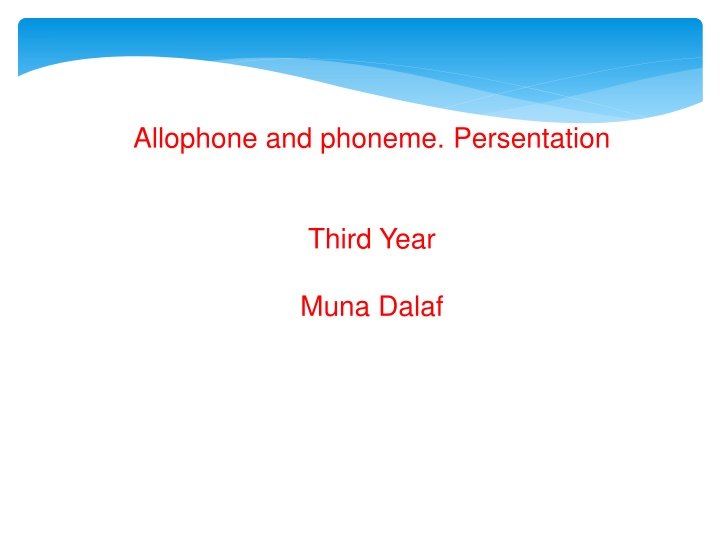
Allophones and Phonemes in Linguistics
Explore the concepts of phonemes and allophones in linguistics, uncovering how different languages organize and realize sounds. Examples from English and Chinese demonstrate the variations in sound production and significance in language systems.
Download Presentation

Please find below an Image/Link to download the presentation.
The content on the website is provided AS IS for your information and personal use only. It may not be sold, licensed, or shared on other websites without obtaining consent from the author. If you encounter any issues during the download, it is possible that the publisher has removed the file from their server.
You are allowed to download the files provided on this website for personal or commercial use, subject to the condition that they are used lawfully. All files are the property of their respective owners.
The content on the website is provided AS IS for your information and personal use only. It may not be sold, licensed, or shared on other websites without obtaining consent from the author.
E N D
Presentation Transcript
Allophone and phoneme. Persentation Third Year Muna Dalaf
phoneme: a basic sound unit of a language o allophone(s): the phonetic variant(s) of a phoneme So, each phoneme comprises a set of allophone, and each allophone is particular realization of phoneme in a particular linguistics environment
PHONEMES are the basic sounds - the significant , non-predictable ones. The different ways the phonemes are realised in various positions are called ALLOPHONES - predictable, and nonsignificant.
Different language can have the same sound and yet organize them differently in their sound system. For example : 1). The phoneme /p/ of English has two allophones. English speakers treat them as the same sound, but they are different: the first the second is unaspirated (plain). is aspirated and Plain [p] also occurs as the p in cap [k p], and the second p in paper [p e .p ]
One, (ph), has a puff of air after the lips open, and occurs at the beginnings of words such as "pit". The other, (p), does not have a puff of air, and occurs after second word such as in "spit".
We can see from the other language 2). In Chinese languages treat these two phones differently; for example : in Mandarin, [p] (written b in Pinyin) and [p ] (written p)
English has there phonemes at the bilabial position. For instance, the phone [ph] and [b] occur in the minimal pair park [phark] versus bark [bak], And the bilabial nasal [m] in mark [mak].
They must, therefore, be allophone (variant) of different phonemes. So we know that there are at least there bilabial phoneme in English, and we have been able to show that the differences between [ph b m] contain significant information for speaker of that language
Usually, the different ALLOPHONES of the same PHONEME are all similar to each other - they form a FAMILY of sounds. We can see this by the fact that the same difference can be allophonic in one language, and phonemic in another.
We say that allophones have complementary distribution in English, s and sh are phonemes, and so have contrastive distribution.
Words PHONEMES ALLOPHONES non-significant non-significant Unpredictable distribution complementary distribution narrow transcription Significant Unpredictable contrastive distribution broad transcription






















